Well, obviously not via Maykop, because it was already present in the pre-Maykop Khvalynsk culture. And also not from Iran_Hotu or Zagros_N -both were shown to be a rather poor fit in Lazarides e.a. 2016. This, in turn, probably has to do with Zagros_N containing some Onge admix that Colchian CHG is lacking (c.f. Lazarides e.a. 2018), and also being more Basal than the latter.
West Georgia (Colchis) as source?
Alright, what about some Upper/ Final Paleolithic or Mesolithic migration from Colchis? Archeology suggests that both took place: As concerns the Paleolithic, layers 3 (around/ shortly after the LGM) and 1 (Younger Dryas/ Epi-Paleolithic) of Kamennaya Balka near Rostov/Don have been archeologically connected to West Georgia, in the latter case with backward linkage to the late Zarzian site of Shanidar in the N. Zagros.
Moreover, while there seems to have beeen a settlement hiatus in NW Caucasia during the LGM, the Late / Final Upper Paleolitic “Imeretian Culture” that is represented a/o by Satsurblia Cave is described to have from ca. 15-14 ky BC onwards expanded into the NW Caucasus, e.g. Gubs Cave (Golanova e.a. 2014, Leonova 2014).
 The Mesolithic Kukrek Culture of Crimea and the Southern Ukraine is commonly seen as offspring of the Imereti (Colchian) Mesolithic. The problem here is that we already have aDNA from the latter, namely Kotias (KK1). So, if the CHG in Steppe EMBA (Yamnaya etc.) came via the Kukrek Culture, KK1 should provide an almost perfect match for it. Unfortunately, it doesn’t. [However, the Kukrek Culture offers a plausible path for yDNA J, yet unattested in ANF/EEF, into MN cultures such as Lengyel. Moreover, the unexpected early “Steppe signal” in the Varna outlier may in fact rather reflect an acculturated Mesolithic SW Ukrainian / Moldavian than an early form of Steppe migration from, say, Khvalynsk or Samara.]
The Mesolithic Kukrek Culture of Crimea and the Southern Ukraine is commonly seen as offspring of the Imereti (Colchian) Mesolithic. The problem here is that we already have aDNA from the latter, namely Kotias (KK1). So, if the CHG in Steppe EMBA (Yamnaya etc.) came via the Kukrek Culture, KK1 should provide an almost perfect match for it. Unfortunately, it doesn’t. [However, the Kukrek Culture offers a plausible path for yDNA J, yet unattested in ANF/EEF, into MN cultures such as Lengyel. Moreover, the unexpected early “Steppe signal” in the Varna outlier may in fact rather reflect an acculturated Mesolithic SW Ukrainian / Moldavian than an early form of Steppe migration from, say, Khvalynsk or Samara.]
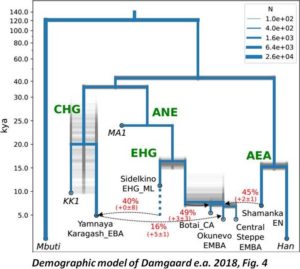 So, problem solved ? Actually, not really. With respect to the recent Damgaard e.a. (2018) paper, many, I myself included, initially focused on the Botai and Hittite aDNA, plus the linguistic annex. But that paper holds additional “goodies”, including a demographic model of East Eurasia that a/o dated the Colchian HG (KK1) – “Steppe” CHG split to around 20 kya, i.e. around the LGM. In fact, depending on the specific set-up of their model, they come up with different split dates, but these dates rather tend to be earlier than 20 kya (see their Supplement S. 2.13). Even when allowing for some leeway downwards, a (pre-)KK1 – “Steppe” CHG split as late as the Final Upper Paleolithic, when NW Caucasia was re-colonised from W. Georgia, is clearly not supported by their analysis. Hence, we need to look for a different source that in all likelyhood hasn’t yet been sampled for aDNA.
So, problem solved ? Actually, not really. With respect to the recent Damgaard e.a. (2018) paper, many, I myself included, initially focused on the Botai and Hittite aDNA, plus the linguistic annex. But that paper holds additional “goodies”, including a demographic model of East Eurasia that a/o dated the Colchian HG (KK1) – “Steppe” CHG split to around 20 kya, i.e. around the LGM. In fact, depending on the specific set-up of their model, they come up with different split dates, but these dates rather tend to be earlier than 20 kya (see their Supplement S. 2.13). Even when allowing for some leeway downwards, a (pre-)KK1 – “Steppe” CHG split as late as the Final Upper Paleolithic, when NW Caucasia was re-colonised from W. Georgia, is clearly not supported by their analysis. Hence, we need to look for a different source that in all likelyhood hasn’t yet been sampled for aDNA.
The South Caspian
 Where might that source have found refuge during the LGM? Paleo-climatic models such as the one displayed here from Arpe e.a. 2011 indicate that there was some possibility to survive the LGM on the Balkans, around the Bosporus, in Colchis, and also on the Lower Don, but where one really wanted to be was either NW Iberia, or Central Italy/ the Adriatic Coast, or the Southern Caspian. Of the above, only the Southern Caspian deserves consideration. A CHG-like refugium on the Lower Don should have resulted in much higher CHG frequencies in Mesolithic Ukraine, and around the Bosporus, Barcin-like ancestry is to be expected.
Where might that source have found refuge during the LGM? Paleo-climatic models such as the one displayed here from Arpe e.a. 2011 indicate that there was some possibility to survive the LGM on the Balkans, around the Bosporus, in Colchis, and also on the Lower Don, but where one really wanted to be was either NW Iberia, or Central Italy/ the Adriatic Coast, or the Southern Caspian. Of the above, only the Southern Caspian deserves consideration. A CHG-like refugium on the Lower Don should have resulted in much higher CHG frequencies in Mesolithic Ukraine, and around the Bosporus, Barcin-like ancestry is to be expected.
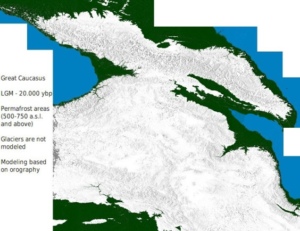
A putative CHG refugium on the South Caspian has three issues:
(1) Paleo-climate models suggest that there may have been a communication channel between West Georgia and the S. Caspian even during the LGM. However, more recent research points towards LGM glaciation of the Caucasus reaching down as low as 500m a.s.l. (which would a/o explain the LGM occupation hiatus at Dzudzuana cave that is located 560 m a.s.l.). In that case, the Colchian and South Caspian refugia would have been effectively isolated from each other, as well as from other presumptive refugia such as the Levante and Mesopotamia, until the the climate improved again around 15 ky BC.
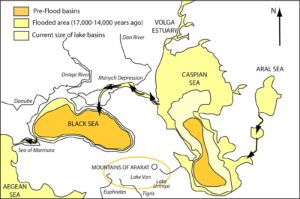
(2) Well evidenced as LGM refugium for a number of species, including the Persian Walnut, the South Caspian so far lacks confirmed evidence of LGM human settlement. The earliest safely dated site is Final UP Komishan (12-11 ky BC), though the lower levels at Kamarband (Belt Cave), reflecting a somewhat different tool composition, may be older.
For lacking connection to world oceans, the Caspian Sea is notorious for substantial sea level fluctuation, with lowstands a/o during the pre-LGM glaciation build-up, and highstands after post-LGM/ post Younger Dryas glacier melt-downs. While the precise timing and extent of these fluctuations is still disputed (compare, e.g. Tudryn e.a. 2016 vs. Chepalyga e.a.), there is consensus about several massive coast line changes since the LGM. South Caspian LGM coastal human sites, if they existed, may now lie some 150 m below current sea level buried under several sediment layers, and even sites closer to or on the current shore are likely to have been covered by Holocene flood sediments [c.f. the Azerbaijani Kura plain that equally witnessed several Holocene floodings, so it took pipeline construction to uncover late 5th mBC Leila Tepe Culture settlements.]
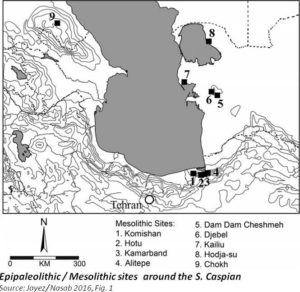
(3) While we don’t have Upper Paleolithic aDNA from the South Caspian so far, there is Mesolithic aDNA, namely Iran_Hotu – and that aDNA doesn’t qualify as source of “Steppe CHG” (see above). However, Iran_Hotu may reflect a late arrival from the Zagros: For inconsistent AMS dates that reach as low as ca. 6,100 BC, Lazarides e.a. 2016 warn that, instead of being Mesolithic, the sample may have been introduced from overlaying Neolithic deposits.
Furthermore, the Final Upper Paleolithic assemblage documented by Jayez/ Nasab 2016 bears little resemblance to contemporary Zarzian assemblages from the Central Zagros, or the Central Georgian Trialetian. It lacks, e.g., burins, (arrow) points, and large geometrics (triangles, trapezoids). The uppermost layer of Komishan, bulldozer-disturbed and as such chronologically unreliable, however, presents a very different picture in terms of technology (pressure-flaking) as well as tool design. A/o, retouched pieces replaced backed ones, and geometric forms appeared – both typical features of the Zarzian. This suggests that Zagros_N – like ancestry only reached the S. Caspian in the EP / early Mesolithic, i.e. contemporary with the Zarzian expansion towards Shanidar in the N. Zagros.
Pre-Neolithic Trans-Caspian connections
 In this context, the issue of pressure-flaking as evident a/o in the disturbed Komishan layers is interesting. Pressure-flaking maximises the cutting edge in relation to raw material input and has therefore been the preferred Neolithic knapping technology. It appeared in W. Iran during the early 9th cBC, where it marks the transition between the Zarzian and the Iranian proto-Neolithic (see Tsuneki e.a. 2007), and subsequently spread from there a/o to the Caucasus, pre-pottery Neolithic Anatolia, and possibly Mergarh.
In this context, the issue of pressure-flaking as evident a/o in the disturbed Komishan layers is interesting. Pressure-flaking maximises the cutting edge in relation to raw material input and has therefore been the preferred Neolithic knapping technology. It appeared in W. Iran during the early 9th cBC, where it marks the transition between the Zarzian and the Iranian proto-Neolithic (see Tsuneki e.a. 2007), and subsequently spread from there a/o to the Caucasus, pre-pottery Neolithic Anatolia, and possibly Mergarh.
Independent invention of pressure-flaking is a possibility envisaged a/o for cases such as the N. African Capsian that lack apparent connection to other cultures using that technique. However, pressure-flaking requires special skills and, more importantly, evolved into several sub-technologies such as the North East Asian Yubetsu method (attested in Jomon from ca. 13 ky BC) that worked on assymetrical cores, or the symmetrical “bullet shaped” cores preferred in West Eurasia. “Bullet-shaped” cores appeared earliest in the SE Uralian Yangielsk(aya) culture, building onto pressure-flaking of wedge-shaped cores as attested on the Upper Angara and Yenisey (Afontova Gora etc.) from ca. 16 ky BC onwards (Goebel 2002). Acc. to Goebel, pressure-flaking arrived on the Upper Yenisey with Trans-Baikal area populations that re-settled SW Siberia after the LGM, while Vasil’ev 1993 rather sees connections with Mal’ta. Noteworthy in this respect is that SW Siberian “bullet cores”, obviously linked to ANE, did not only spread towards the Near Eastern (and eventually European) Neolithic, but also along a north-western path towards the Mesolithic Baltic Sea (Kama-Perchora, Butovo, Kunda, eventually late Magelmose / Duvensee – good discussion in Szymczak 2002, updated in Harz e.a. 2010).
Iran_Hotu incroporates some 9% EHG (Lazarides e.a. 2016, in f4-stats MA1 is preferred over EHG). Underhill e.a. 2014 report that 21 of their 24 R1a(xR1a1) samples stemmed from Iran, especially Iranian Azeris, and E. Turkey. In all likelyhood, this refers to Near-Eastern-specific (Georgia to Yemen) R1a2b (YP5018) that wasn’t tested for in their study. Acc. to yFull, R1a2b formed some 12.1 kya, i.e. at the end of the Younger Dryas. This suggests epi-ANE/proto-EHG migration out of the SE Urals towards the S. Caspian around the Younger Dryas, eventually introducing pressure-flaking of “bullet-shaped” cores into the Iranian proto-Neolithic.

Details of the migration path are yet unknown. Turkmenistan/ NW Uzbekistan provides an obvious link, and the region’s Kelteminar Culture (best evidenced at Ayakagytma/UZ) is well evidenced for using “bullet-shaped” cores, but Kelteminar is Neolithic and post-dates the arrival of pressure-flaking in Iran. Nevertheless, several researchers have speculated about such path (e.g. A. Collins: “The Cygnus Key..” 2018, Brunet 2012). A problem here is the complete absence of Mesolithic finds from the area, which in turn may relate to frequent floodings of the Aral-Caspian basin not only during the late Pleistocene but also the Holocene (see above). Moreover, under such scenario one would expect R1a2b to also be present in Central Asia that, however, doesn’t seem to be the case (c.f. Underhill e.a. 2014, Table S4).
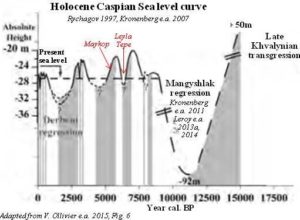
So, alternatively, one should consider a direct connection. Mesolithic S. Caspians possesed sea-worthy boats, as attested from petroglyphs at Gobustan (see picture above, note the bow-equipped hunter just below attesting Mesolithic rather than Neolithic context) that should have allowed for crossing the Caspian Sea. In fact, they might not even have needed boats, as the Younger Dryas reduced the Caspian Sea to a record lowstand (the Mangyshlak regression) that completely exposed the continental shelf. [During the following flood, at the onset of the Holocene, however, seaworthy boats were certainly of advantage.]
There are also indications of epi-Paleolitic and Mesolithic trans-Caspian Sea contact in the opposite direction: The rather poorly documented SE Uralian Yangielsk(aya) Culture is generally described to display South Caspian influence (e.g. Matyushin 2009, p 137). Acc. to Szymczak 2002, citing Matyushin 1986, the tools from Shikaevka II (on the Tobol somewhat north of Kurgan) correlate with the earliest layers of Kamarband (Belt Cave) that precede the Final Upper Paleolithic (12-11 ky BC) Komishan sequence. Shikaevka II has been C14-dated to ca. 18 ky BP (uncalibrated), which calibrated would be around end of the LGM (Y. Kuzmin 2008), as such (i) placing early Belt Cave into the LGM and (ii) providing a West Siberian entrance point for CHG-like ancestry that is compatible with the Damgaard e.a. 2018 demographic model. However, the dating is questionable:
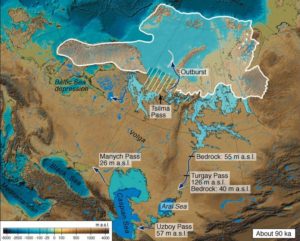
- It is based on a single measurement of a mammoth bone from the cultural layer. As Kuzmin himself notes, UP humans often scavenged bones from mammoth cemetaries as fuel or for tool making, and there are several cases where mammoth bone dates contradicted other dates from the same site (c.f. Graf 2009 for a more general criticism of Kuzmin 2008). And, in fact, other authors trying to date Shikaevka II based on geomorphology and stratigraphy had come up with dates around 13 ky 14C BP ~ 13,600 calBC;
- It just doesn’t make sense to during the LGM leave the apparently quite cosy South Caspian coast for mammoth hunting in the Taiga 3000 km further north. OTOH, the post-LGM flooding of the Caspian Basin that set in around 15 ky BC provided lots of reasons for migrating north, and the low-lying Turgay pass that was created by a 90 kya glacial spillover into the Caspian basin (Mangerud e.a. 2004) provides a convenient route from Turkmenistan/ W. Kazakhstan to the Tobol river.
As such, I think a 14mBC (13 ky uncal. BP) dating of Shikaevka II, as proposed based on geomorphology and also put forward by Powers 2012, aligns best with both the S. Caspian archeological evidence and climatic/ hydrological considerations.
Acc. to Mosin 2000, the majority of (Late) UP sites of the Southern Urals have been radiocarbon-dated to 12-11 mBC, which raises some concern to which extent Shikaevka II can be regarded as representative, and whether Matyushin’s construct of a Yangielsk Culture that unites Shikaevka with those later attestations is sensible. Nevertheless, for Mosin “the uniform cultural space between the territories of the Transurals in north and the areas East Caspian and Aral region in the south probably at this time is made out.” The author sets forth: “The basic attributes the material culture of the Mesolithic Southern Transurals almost coincides with the characteristics of the Mesolithic Upper Tobol (Evgenjevka I, Duzbay UI, Ubagan III, etc.) and Average Transurals (Seryj Kamen, Vyjka II etc.). On the basis of general characteristic features Mesolithic sites of the specified territories can be united in the Transurals Mesolithic cultural generality. The nearest analogies the sites of the Transurals Mesolithic generality can find in north — with the Mesolithic of the Western Average Ural and in the south — with the Mesolithic sites of the Eastern Caspian.” He/she concludes: “During of the early Holocene the territory of the Transurals in north and the Eastern Caspian and Aral region in the south were closely connected among themselves.“
In conclusion, there seems to have been a trans-(east-)Caspian communication sphere in existence since at least the 14th mBC that a/o transferred South Caspian geometrical and lunate forms northwards, and Siberian pressure-flaking of “bullet-shaped” cores southwards. This communication left visible ANE genetic imprints in N. Iran (Hotu, R1a2), and may also have been a source of the EHG admixture in Namazga_BA , modelled as 79% Iran_N, 21% EHG by Damgaard e.a. 2018.
Mesolithic CHG North of the Caspian Sea ?
Its genetic impact on SW Siberia and NE Europe, however, is uncertain. CHG wasn’t lasting in SW Siberia, as evidenced by Botai aDNA (Botai sites extended towards the upper Tobol, see Brunet 2011), but Botai possibly represens an early Holocene arrival from further east, e.g. the Altai or Baikal.
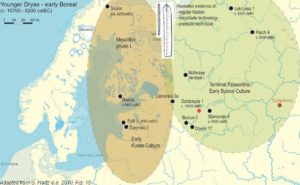
More suspicious in this respect is the apparent absence of CHG-like ancestry in early Holocene (post-Younger Dryas) Sidelkino north of Samara. That sample is poorly described archeologically, the best I could find is Vasylev e.a. 2014. Nevertheless, general descriptions of the EP/ Early Mesolithic lower and middle Volga stress a dualism of “Western” and “Uralic” traditions. The former is alternatively related to Swiderian (Volotkin 2003) or Ahrensburgian (Galimova 2005) influence, neither of which is particularly likely to have been dominated by EHG, so Sidelkino_ME probably represents the “Uralic” tradition. That tradition is primarily associated with the spread of pressure-flaking of “bullet-shaped” cores, which at the time of Sidelkino_ML acc. to Harz e.a. 2010 had already reached the Early Butovo Culture further NW. The spread of pressure-flaking most likely involved a demic component – Mittnik e.a. 2018 report up to 35% EHG in the (late Kunda) Baltic Mesolithic.

But is CHG really absent from Early Holocene samples? I asked Alberto for some G25 runs – the table to the left presents his best outputs with distal sources. And, apparently, Sidelkino and WestSiberia_N contained some CHG ancestry – not much, but above noise level. The homeopathic CHG in SHG and Botai disappears when Sidelkino and WestSiberia_N are added as sources, meaning it travelled onwards with them.
Conclusion
So, in the early Holocene we find traces of a Trans-Caspian CHG-EHG cline, marked by 9% EHG in Iran_Hotu and 3% CHG in Sidelkino, which mirrors the exchange of stone knapping technologies between the South Caspian and W. Siberia. In theory, somewhere in-between there should have been a point with some 50-50, “Steppe-like” mix. That point may have been the Upper/Middle Tobol (Yangielsk Culture), where the corresponding population either died out during the Younger Dryas, and/or was replaced by “eastern” Botai and WSHGs. But the “equilibrium point” may also have been further south. Steppe admix may have been well present in Kelteminar, as hypothesized by Naramsinhan e.a. 2018 in order to explain early “steppe” signals w/o EEF, i.e. unrelated to Steppe_MLBA, in the Gonur outlier. Moreover – so far we only have one sample from the Caspian coast, namely Iran_Hotu. The 9% EHG there may just have been the tip of the iceberg. IOW – the EHG signals in Armenia_CA and Armenia_EBA may theoretically stem from populations that were already present in the South Caspian during the early Holocene.
So – there remain lots of uncertainties, until we get more Final Upper Paleolithic and Mesolithic samples from the areas in question. Easier said than done – so far there are neither South Caspian archeological sites that can securly be dated to the LGM, nor Final Upper Paleolithic and Early Holocene sites known from the West Asian (Kazakhstan/ Uzbekistan) Steppe (both of which possibly has to do with the frequent cycles of floods and lowstands of the Caspian and Aral Seas). As long as these uncertainties prevail, it is advisable to not instantly attribute each occurence of EHG-CHG admix to the European Steppe (Yamnaya etc.).
The Sidelkino sample, however, makes us reasonably certain that during the early Holocene CHG ancestry wasn’t yet widespread around Samara. The bulk of it only arrived during the Neolithic. When and from where I shall explore in the second part of this series.

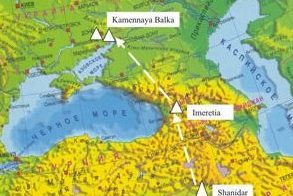

Cool post. I’ll comment on few points
1) Odds are the source of CHG in steppe Eneolithic/ Yamnaya is ”Colchis” HG, esp. given that the north Caucasus steppe Eneolithic had the highest CHG c.f. Khvalynsk. Also, I would not take too literally the estimated ages from DNA. The poor fitting could be due to individual drift paths between CHGs from Georgia and those in the Kuban region.
2) ”The Mesolithic Kukrek Culture of Crimea and the Southern Ukraine is commonly seen as offspring of the Imereti (Colchian) Mesolithic. ”
I’m not sure about ”offspring”, but it has certainly been proposed to be influenced by it. However, the Dnieper rapids Mesolithic cemeteries fall within the territorial and chronological range of the Kukrek-Grebenki entity. Curiously they lack CHG
3) ” And, apparently, Sidelkino and WestSiberia_N contained some CHG ancestry – not much, but above noise level”
I’d call 0.5 – 2% ”noise” 🙂 It would be zero with qpADM.
But i agree about the well described contacts with the eastern Aral zone, but perhaps these were more ANE/ Siberian -like instead of CHG.
4) ”This communication left visible ANE genetic imprints in N. Iran (Hotu, R1a2), and may also have been a source of the EHG admixture in Namazga_BA , modelled as 79% Iran_N, 21% EHG by Damgaard e.a. 2018.”
However, Damgaard lacked the SIberia _Neolithic & Botai samples from Narasinham. With those, the admixing component seems to be ”Siberian” HGs.
One interesting detail about the formation of ancient Iranian components is that the geographically quite south-western Zagros farmers do seem to have the shortest FST-distance to East Eurasians (in the Lazaridis paper represented as Han) out of all Holocene West Eurasian populations, despite the fact that their substantial Basal Eurasian ancestry should, in theory, increase their relative distance to East Eurasians. Yet they are significantly closer to East Eurasians than EHG, CHG, WHG etc. .
What this indicates to me is that there was a migration from the east that gave rise to said population, and like with the steppe component those Zagros components might have formed independently in several locations by way of similar admixture events between populations. Therefore I would caution that EHG admixture might also be a statistical relic of differential affinities between Villabruna, Basal Eurasian and the East Eurasian component.
I would guess that a population that could have caused such a significant eastern shift in the Zagros farmers would have entered Iran from the south-east, but I do not know whether this would fit the archaeological record or whether research has been conducted in those places at all. In any case I think samples from South Central Asia and India will be crucial to explain those processes – think of for example the recently detected CHG admixture in Mal’ta.
@Rob:
1) Odds are the source of CHG in steppe Eneolithic/ Yamnaya is ”Colchis” HG
Certainly not! From https://www.sciencedirect.com/science/article/pii/S1563011013000585 :
“The emergence and distribution of a production economy in western Georgia remains a contentious issue. To date, no Neolithic sites have provided evidence of sedentism or animal domestication. This conclusion is upheld by findings of new excavations carried out at a number of sites – Anaseuli I, Gurianta, Urta, Kobuleti, Odishi, and Paluri attributed to the Neolithic.”
While lacking AMS dating, Chataigner e.a. (http://www.oxfordhandbooks.com/view/10.1093/oxfordhb/9780199935413.001.0001/oxfordhb-9780199935413-e-13) typochronologically assign the a/m sites to the LN (Shulavery-Shomu)/ early CA (Sioni), i.e. from ca. 5.5 ky BC onwards.
Housing remains and bones of domesticated sheep/goat in Rakushechny Yar on the Lower Don date to 6.5 ky BC at latest, and hence cannot have arrived from W. Georgia (nor from the Balkans that also was neolithicised later). But I’ll explore that question in more detail in Part 2 of this series.
Also, I would not take too literally the estimated ages from DNA.
True. However, if at all, the separation point may have been underestimated due to some Colchian HG reaching SE Ukraine during the EP or Mesolithic.
2) the Dnieper rapids Mesolithic cemeteries fall within the territorial and chronological range of the Kukrek-Grebenki entity. Curiously they lack CHG.
Do they? Alberto ran a G25 model on them, with AG3, Villabruna, Loschbour, Barcin and CHG as sources, and came out with 1.4-9.4% CHG (avg. 5.2%). That’s quite a lot! A good part of this CHG disappears when Sidelkino is used as source instead of AG3, but even in this set-up, I1733 retains 4% CHG, and I5876 2.6%. That CHG admix can IMO confidently be assigned to Colchian HGs, and provides some baseline on the amount of non-Colchian CHG that entered South Ukraine afterwards.
4) Damgaard lacked the SIberia _Neolithic & Botai samples from Narasinham. With those, the admixing component seems to be ”Siberian” HGs.
Well, Narasinham, who posessed these samples, hypothesized about Kelteminar as source of early “steppe” signals in the Gonur outlier. Let’s hope we one day will get Kelteminar aDNA for a clearer view.
@Marco
the geographically quite south-western Zagros farmers do seem to have the shortest FST-distance to East Eurasians (in the Lazaridis paper represented as Han) out of all Holocene West Eurasian populations
I am not sure to which Lazarides paper you are referring. Lazarides 2018 models Zagros_N without Tianyuan or Han admix as 58% Dzudzuana, 21% AG3, 11% Onge and 10% Mbuti (Basal). However, the p-value isn’t particular good at 0.129, so adding Tianyuan as a fifth component might improve the fit.
As concerns archeology: Similar to the spread of “bullet-shaped cores” from W. Siberia into W. Eurasia, the East Asian Yubetsu variant of pressure knapping entered Eastern Central Asia during the Mesolithic from W. China (c.f. Brunet 2012 linked in the main post). However, I am uncertain whether that introduction happened early enough to substantially affect the genetic make-up of Zagros_N. Moreover, Yubetsu knapping apparently didn’t progress further westwards. Neolithic Western Central Asia (Kel’teminar, Jeitun) used the W. Siberian bullet-shaped method.
East Central Asia is reasonably well documented archeologically and has supplied a number of Final Upper Paleolithic sites, some of which may possibly even have been used during the LGM. I have just skimmed over respective papers, and decided to leave a closer look to some later point in time. Nevertheless, my impression is that while UP links to South Asia (Kabul-Indus basin) are regularly considered, nobody has yet suggested a connection to (West) China.
@ Frank
Thanks for your reply
W.r.t # 1, I suspect you might be confounding 2 different issues – CHG in the steppe and the source of domestication in the steppe
And – your date of 6500 BC for domesticates in the lower Don seems to be based on earlier, Soviet work when there was mixing of layers and attribution of wild aurochs as domestic cattle
Now, the date has been revised down to the Eneolithic for the earliest likely date for domesticates
In this regard, the CHG might have reached with Epipaleolithic Imeretian groups, as outlined in your post. Shuvaleri’s dating is therefore a separate issue
@FrankN
I am referring to the Fst-distances cited in Lazaridis (2016). Here’s a summary:
https://2.bp.blogspot.com/-5-URy6M5-Nk/V28Tv8HAgrI/AAAAAAAADXo/MBtLyUj5f3QUaPwq66RJz9tLlCJMKaDwACLcB/s1600/genetic-distances.png
I am not sure how solid this approach is however.
It is my belief that the problem with Lazaridis model is that the ENA components in both ANE and Zagros are could be closer to Austronesian groups than to Onge or Han. I believe in Raghavan’s Mal’ta paper the Taiwanese Ami gave the best fit.
Frank,
are you suggesting that the CHG in the Eneolithic and Bronze Age steppe is from Kelteminar. I’d be surprised if this is the case, nevertheless I find it a very interesting culture group. From what I recall it is comprised of sub-Neolithic hunters which might vae similarities to those north of the Caspian. Is there any recent publications on it ?
@Rob:
I wasn’t talking about Aurochs vs. domestic cattle, I fully aggree with you in this respect.
The issue is ovocaprids (sheep and goat) – their natural habitat is mountain areas, so any occurence outside that habitat, e.g. in the Steppe, is a clear indicator of domestication.
I understand that one Ukrainian piece that originally was assigned to ovocaprids has now been reassessed as stemming from the Saiga antelope. However, the final verdict on the remains from the Lower Don is still out.
@Toby
F. Brunet, the leader of the Mission Archéologique Française en Asie Centrale has made various publications about Kelteminar, most of which unfortunately are in French. If you understand French, I recommend http://www.persee.fr/doc/paleo_0153-9345_2005_num_31_2_5127 .
Otherwise, first a technical note: Kelteminar is also a Steppe culture, just on the Asian side. And yes, they were hunters and fishers, with a semi-nomadic lifestyle, but also had domesticated cattle, sheep and goat, and erected temporary mud-brick dwelling, which attests their connection to Iran (for the more southerly, sedentary Neolithic Djeitun culture, the Iranian connection is even more obvious). At the same time, “bullet-shaped” pressure knapping attests cultural relation to the Trans-Ural. Last but not least, Brunet argues for some kind of continuity with preceding Mesolithic traditions.
For everything else, you will have to wait for the rest of the series. Kelteminar will play a role there, but the picture is much, much more complex ….
@ Rob and Frank,
I agree with Rob. Lets leave the Shulaveri alone … for now. 🙂
This a piece of my Shulaverian Hypothesis:
“We need to fight our tendency to view events as a video game with levels that we move to. Things will be revealed as multifaceted. It is worthwhile to refer that this channeling time of 6000-5500bc Is where we see the same archeological signs mixing between Shulaveri proper and the western Georgia, land of the Kotias the one we call the original CHG (Caucasus Hunter Gatherer). These archeological sites are known as Odishi, Anaseuli and Chkhortoli. It will be of utmost interest when we have the genome for these specific population in western Georgia, oppose to Shulaveri proper in eastern Georgia, and its role in early north Caucasus and steppe population. There is a baseline that is not usually taken into account, which is that prior to the arrival of the Shulaveri, there was an underlying substratum of people, totally unsampled and in my view “unseen” in terms of genetics which will show the true colors of CHG. The Mesolithic people that lived from eastern Anatolia to western Georgia, to north mesoptamia, best represented as the Kmlo-2 tools, and the “Çayönü tools”, from Georgia Dzudzuana and the Lake Sevan itself. This is all prior to arrival of the Shulaveri. “
I think is appropriate to insert the paragraph following the one above…
These folks arriving, while admixing with any local remains of pure CHG, would diverge from the others that at the same time or even a bit earlier arrived in Aratashen/Arknashen whose admixing would later have been more with Iran Neolithic Dna. The same holds true with the ones moving from the core region of Kvemo-Kartli and Shulaveris Gora to the Azerbaijan into the Karabakh steppes admixing as well with Iran Neolithic. So, those others, from western Georgia, for sure started to move up the eastern cost of black sea. Who knows if not reaching north Caucasus by say 5500BC? The route was open.
Crucial to our story and at a point in time and space, the Shulaveri just were. Just themselves. Although I admit my fascination and passion for the Shulaveri, to me always they always strike me as singular (in the sense of different). In fact we know from 2017 papers, from Margaryan and Derenko et al. , that the Shulaveri at least carry the Mtdna H2 + 152, H15a1 and I1 which is totally not Anatolian or Iran farmer Mitochondrial DNA haplogroups.
Guys,
Made a webpage with Shulaverian Hypothesis in Maps.
Seems easier to understand.
https://shulaverianhypothesis.blogs.sapo.pt/
I think it looks nice. Feedback appreciated.
@OM
Thanks for sharing. I think that’s a nice way to present the data, in a very visual way. And a good effort to do it.
I’m still wondering why you picked Shulaveri-Shomu, an Early Neolithic culture, and why you link it to PIE and R1b-L23 (both of them post-date the S-S culture’s end, according to most researchers’ dating).
In any case, stay tuned for FrankN’s second part of this series that will deal with the Neolithic contacts between the steppe and its surroundings. There will be a good amount of information there to contrast with your own research.
Alberto,
Looking forward to FrankN’s Second part. Usually very dense but informative. 🙂
Most researchers just recently had all the money bet on Steppe as origin of PIE and Suddenly are betting on South caucasus.
Older Bayesian models had PIE older. So, 5300-5000 for its formation works just fine. I suspect the reason for younger dates had more to do with archeology than anything else.
To me Shulaverian Hypothesis is so obvious that I even find it hard to believe others don’t see it. In the end I will be the crazy guy or the genius – however I don’t expect recognition, instead a hard battle to be more visible than the wrong Armenian Hypothesis.
Note: Have you notice the “embargo” from the big labs on Neolithic transcaucasia (6000-5000bc) and chalcolithic South Balkans (4500-3800bc) samples? Either a coincidence or they are just milking the cow of other samples before definitive proof. Because finding R1b-L23 and PIE will surely be the highest point for this young discipline. From there on everything will be second best. Lets us see if there is not an “Archeogenetic gate” 🙂
@OM
Yes, I do agree that the dating of PIE is just a speculative estimate. I generally considered Anthony’s reasoning about the lexicon related to wheeled vehicles like a good argument (not definitive as he tries it to be, but quite convincing – unlike his argument for the place of PIE based on the assumption of language contacts with Proto-Uralic and proto-Kartvelian, which is very poor one). But I’ve found some strong criticism about his linguistic arguments too:
Wheels, Languages and Bullshit (Or How Not To Do Linguistic Archaeology)
Which makes me more sceptic about that part too (criticism is rather harsh, but not totally undeserved, IMO – if only because of the dogmatic presentation of the arguments in the first place).
I’m sceptic about R1b-L23 being PIE too, so I don’t expect that to be fundamental. However, the South Caucasus is clearly a good candidate for PIE, so let’s see what further samples from the area can tell us. Those will surely come (no embargo, IMO). I fear more the lack of Northern Mesopotamian ones (arguably the most important area in West Eurasian prehistory), but that’s a consequence of the war and political instability of the region.
OM,
There are some nice illustrations.
Some of the theory there is questionable – a Farming of sorts began in the Iron Gates ?
I’m not aware of migration from Balkans west to north Anatolia until 4500 BC., where did you obtain this perspective from ?
Hi Rob,
Thanks. The problem with maps versions is that its highly reductionist. Not like the Hypothesis itself which is worthwhile reading it. Specially the 2018 version in pdf. (https://shulaveri2bellbeaker.blogs.sapo.pt/)
Iron Gates – I don’t say Iron gates had agriculture. What I say is that by as of 7000BC we do see a movement of farmers moving up Thrace and Bulgaria which is easy to find once one gets to local Bulgarian Neolithic papers. Simultaneous as the movement of farmers to make Starcevo-Cris-Koros was underway by 6500BC from the north into Romania. What I say is….
“… a population which could be already M269 (or very close to become it by mutation) , lived in south Balkans. Romania, Bulgaria even parts of Serbia, around the dates of 7500-6300BC.
I hypothesize that there is a good chance the ones that became later the Shulaveri were in Romania, in archeological places such as Ostrovul Corbului, Schela Cladovei, Ovcarovo Gorata, eventually even Lepenski_Vir in Serbia. In fact, we could use also as example places in Iron gates that did seem to have ended the settlements at those dates like Climente II, Hajdučka Vodenica, Icoana, Kula, Ostrovul Corbului, Padina, Schela Cladovei or Vlasac to contrast to others around it that kept on being occupied. So, places that were abandoned by 6300BC, are places that could have contributed to the future Shulaveri Population. Subsequently we can say that Shulaveri can very well be related to the IRON GATES hunter gatherers of the Mesolithic. “
Regarding the movement of people into North Anatolia, I primarily follow this….
“Conoly 2012 that finds correlations regarding uncommon amounts of big cattle between sites such as Ovcarovo Gorata (Romania) to Fikirtepe and even as far way as Hogoshim in north Israel at earlier dates. The other name is Halula tell (Halaf). I just added Shulaveri to the list that Conoly and kate Manning did not. It would not surprise me, at future times when we have mapped thoroughly the aDna of all those cultures, that Halaf culture turns out to be R1b of some sorts (even V88 from iron).” “
Now, Movements from Balkans to Anatolia by 4500BC? well i see movements of North Analotia (KUM6 Girls kind of people) into Balkans and not really the other way around (even although that can also occur.
If you want to find Shulaveri after the 4900BC event… find them in Bulgaria Boian culture by 4900BC…. and they went trough Anatolia.
Wonderful post, FrankN.
For Ghobustan pictures: https://donsmaps.com/gobustan.html
ANE/Botai Sumerian connection at sumerianturks.org
Thanks, Mehmet
I have only scanned over your blog (at the moment I am busy with finalizing my part II), but at first sight it looks quite interesting, and I will give it a closer look once I have the time. Within all the “linguistic homeland” riddles, Turkic certainly requires equal attention to all the other language families. I don’t know enough about Turkic for any qualified opinion/ comment in this respect, but I am eager to learn more.
Sumerian is on my agenda, and I plan for a post about it once the archeological/ aDNA base has been clarified. Let me just say for the moment that there is quite some indication for Sumerian-PIE language contact beyond the “red” -> Sumerian URUDDU “copper” connection discussed on your blog.
When reading about Sumerian, I a/o came across a paper proposing a genetic affiliation of Sumerian to Turkic, more specifically to Oghur Turkic (Chuvash) that looked well enough done to not be discarded immediately: I. Kenanidis 2013 “Yet another Suggestion about the origins of the Sumerian language”.
As I have said, I am currently busy with other things, but if you stay tuned, we shall have opportunity to discuss about the place of Sumerian within the Near Eastern Bronze Age linguistic landscape. The place of proto-Turkic within that landscape is something I haven’t yet thought much about, and I look forward to learning more about your ideas in this respect.
Dear Frank N,
Thanks for your comments. I have included Kenanidis’ great work as well as Parpola’s seminal works (2007-2016 paper/book) and many others on my website since 2016! Computer scientist Peter Revesz has a very interesting approach for undeciphered languages and certainly requires attention, I have listed his work on the home page too. Ogur Turkish-Hungarian- Finnish and Sumerian connection is well established.
As you said, PIE-Sumerian connection goes well beyond the word for “Red” as I have shown in my book and articles. For example, Sumerian-PIE-Afroasiatic:
http://sumerianturks.org/bull.htm
I am looking forward to your next post and I will link your post from my website homepage as a featured article for January 2019.
Keep up the great work. Thanks, Alberto Gonzales for this great website, I had linked and suggested your site back in August.
Mehmet Kurtkaya